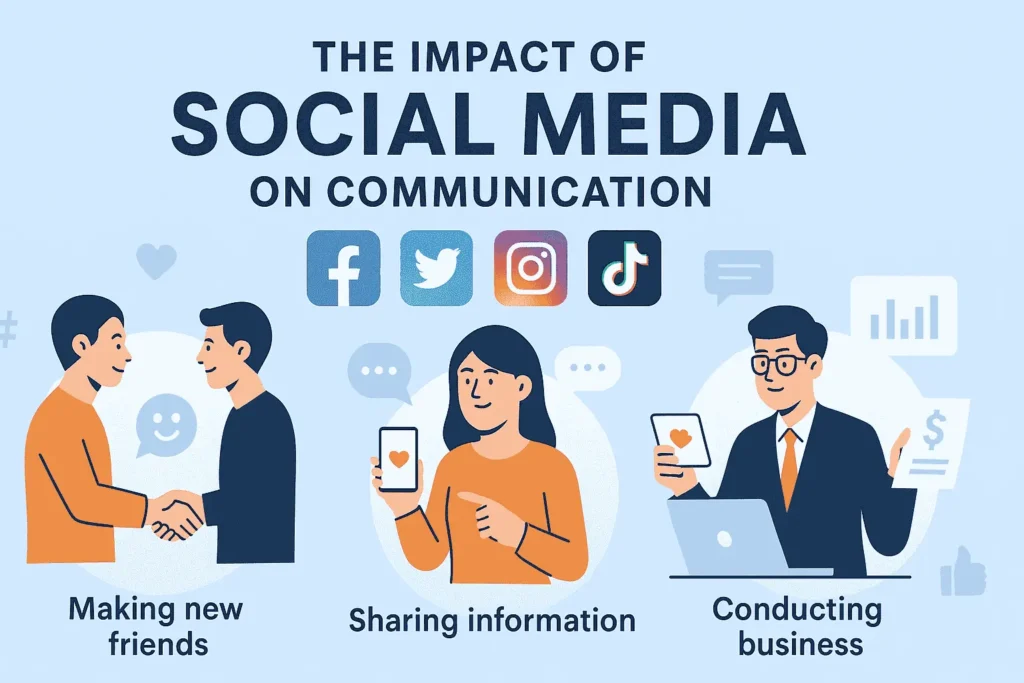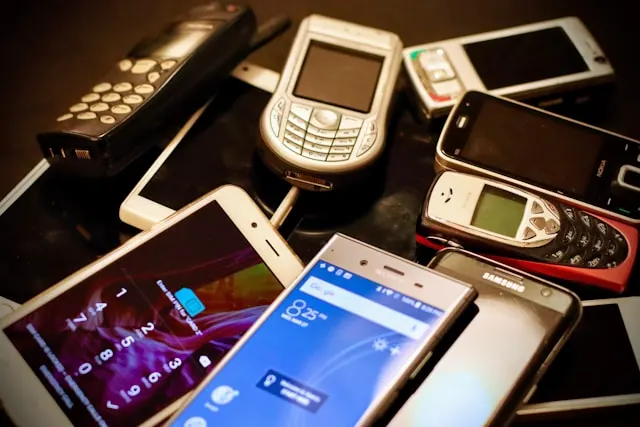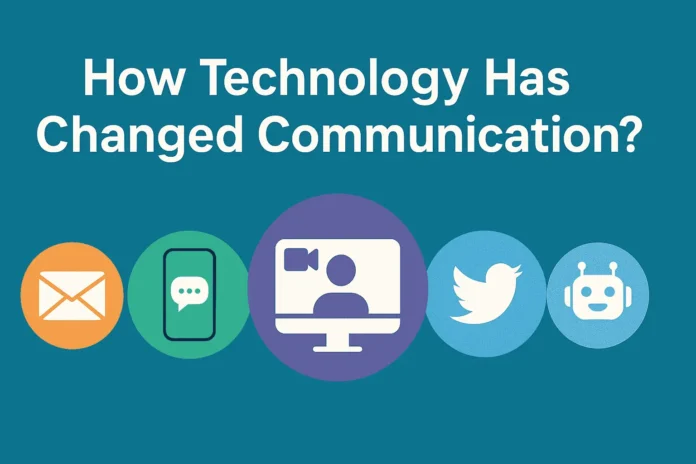Technology has transformed nearly every aspect of our lives, but perhaps nowhere is this more evident than in the way we communicate. From the days of sending letters by mail to instant messaging and video calls, the evolution of communication technology has been nothing short of remarkable. This blog post explores how technology has revolutionized communication, answering common questions and providing insights into the past, present, and future of human interaction.
Introduction
Have you ever stopped to think about how much technology has changed the way we communicate? Not too long ago, staying in touch with loved ones meant writing letters that took days or even weeks to arrive. Today, we can send a message or make a video call in seconds, no matter where we are in the world. This shift hasn’t just made communication faster—it’s also changed how we connect, share information, and build relationships. In this article, we’ll take a closer look at the impact of technology on communication, exploring key milestones, the role of social media and mobile devices, and what the future might hold.
The Evolution of Communication Technology
To understand how far we’ve come, it’s helpful to look back at some of the major milestones in communication technology. Each of these innovations has played a crucial role in shaping the way we interact today.
The Telephone: A Game-Changer for Real-Time Communication
The invention of the telephone by Alexander Graham Bell in 1876 marked a turning point in human communication. For the first time, people could have real-time conversations with someone miles away. Before the telephone, long-distance communication relied on written letters or telegrams, which were slow and limited. The telephone made it possible to hear a loved one’s voice instantly, shrinking the world in ways that were previously unimaginable. Businesses could coordinate faster, families could stay closer despite the distance, and even emergencies could be handled with greater speed. This breakthrough laid the foundation for many of the communication tools we use today.
The telephone wasn’t just a technological marvel—it also changed how people thought about distance. Suddenly, a neighbor across town felt as close as someone across the country. While it didn’t replace letters entirely, it offered a new level of immediacy that set the stage for future innovations. It’s hard to overstate how much this single invention shifted the way humans connect.
The Internet: Connecting the World Through Email and Beyond
The rise of the internet in the 1990s brought another wave of change. Email quickly became a faster and more efficient way to send messages compared to traditional mail. Instead of waiting days for a letter to arrive, you could send an email and receive a reply within minutes. This speed transformed both personal and professional communication. Businesses began to rely on email for quick updates, while individuals used it to stay in touch with friends and family across the globe.
But the internet didn’t stop at email—it also paved the way for instant messaging, online forums, and eventually, social media. Instant messaging allowed people to chat in real-time, much like a phone call but without the need for a voice. Online forums created spaces where people with shared interests could exchange ideas, no matter where they lived. These platforms made communication more interactive and accessible, connecting people in ways that went beyond what the telephone could do. The internet truly made the world a smaller place by enabling global communication at the click of a button.
Smartphones: Communication at Your Fingertips
The introduction of smartphones in the late 2000s took communication to a whole new level. These pocket-sized devices combined the power of the telephone, the internet, and even cameras, making it easier than ever to stay connected. With smartphones, you can send texts, make calls, check emails, and browse social media—all from one device. This convenience has made communication more immediate, allowing us to reach out to friends, family, or colleagues no matter where we are.
Smartphones also introduced new tools like messaging apps—think WhatsApp, Telegram, and Signal—which offer free texting and calling over the internet. These apps have made it cheaper and simpler to talk to people far away, especially internationally. Beyond that, smartphones have become a hub for other forms of communication, like video calls and social networking, blending different technologies into one seamless experience. They’ve turned communication into something we carry with us everywhere, always ready at a moment’s notice.
The Impact of Social Media on Communication

Social media platforms like Facebook, Twitter, Instagram, and TikTok have fundamentally changed the way we interact with others. These platforms have not only made it easier to stay connected but have also transformed how we share information, express ourselves, and even conduct business.
Building Connections and Communities
One of the biggest ways social media has changed communication is by helping people build connections and communities. Whether it’s reconnecting with old friends, meeting new people with similar interests, or joining online groups, social media has made relationships easier to form and maintain. For example, Facebook groups bring together people who love the same hobbies, support the same causes, or share the same experiences. This creates a sense of belonging that doesn’t depend on living nearby.
During times like the COVID-19 pandemic, when meeting in person wasn’t always possible, social media became a lifeline. People turned to platforms like Instagram and Twitter to check in on friends, share updates, or just feel less alone. This ability to connect across distances has made social media a powerful tool for keeping relationships alive, even when life gets in the way.
Sharing Information and Ideas
Social media has also become a major way to share information and ideas. Platforms like Twitter let users post quick updates or thoughts that can reach thousands of people in seconds. Instagram and TikTok take it further with photos and videos, letting anyone create content that’s fun, informative, or inspiring. This has given everyone a chance to speak up and be heard, not just big companies or news outlets.
However, this openness comes with a downside. Misinformation can spread just as fast as the truth, sometimes causing confusion or harm. Still, the ability to share and discover new ideas has made social media a key part of how we communicate today. It’s a space where anyone can contribute, learn, and engage with the world around them.
Changing the Business Landscape
For businesses, social media has opened up new ways to talk to customers. Companies can now post updates, answer questions, and hear feedback directly from the people who use their products. This direct line of communication has made businesses more approachable and responsive. Plus, social media ads let them target the exact people they want to reach, based on things like age, interests, or location.
This shift has also changed how businesses build trust. A clever tweet or a relatable Instagram story can make a brand feel more human, while a quick reply to a customer’s comment can show they care. Social media has turned business communication into a two-way street, where listening is just as important as talking.
The Role of Mobile Devices in Modern Communication

Mobile devices, especially smartphones, have become a huge part of our lives, and their impact on communication is massive. They’ve made it possible to stay connected anytime, anywhere, and have brought new ways to reach out to others.
Instant Messaging and Texting
Texting and instant messaging apps have taken over as one of the most popular ways to communicate. Apps like WhatsApp and Messenger let you send messages, pictures, or even voice notes instantly, often for free. This has made staying in touch easier and cheaper, especially with people far away. Unlike phone calls, texting doesn’t need both people to be free at the same time—you can reply whenever it works for you.
This flexibility has changed how we talk to each other. Quick messages have replaced long letters, and emojis often stand in for words. It’s a fast, simple way to keep conversations going, whether you’re checking in with a friend or planning a meeting.
Video Calls and Virtual Meetings
Video calling apps like Zoom, Skype, and FaceTime have made it possible to see and hear people no matter where they are. This has been a game-changer for remote work, letting teams meet face-to-face without being in the same room. It’s also helped families stay close, with grandparents watching grandkids grow up through a screen or friends catching up over a virtual coffee.
During the pandemic, video calls became even more important, keeping businesses running and classrooms open. They’ve made communication more personal than a phone call, adding a visual connection that feels closer to being together. It’s a tool that’s here to stay, blending convenience with a human touch.
Social Media on the Go
Smartphones have made social media something we can use anywhere. Whether you’re waiting for a bus or relaxing at home, you can scroll through Twitter, post on Instagram, or watch TikToks. This has changed how we get news and entertainment—many people now rely on their phones instead of TVs or newspapers.
But being always connected has its challenges. It’s easy to spend too much time on screens, and constant notifications can feel overwhelming. Still, the ability to jump into social media whenever we want has made it a central part of how we communicate and stay informed.
The Future of Communication: What’s Next?

Technology keeps moving forward, and the way we communicate will keep changing too. New tools like virtual reality, artificial intelligence, and the Internet of Things are already starting to shape what’s coming next.
Virtual Reality and Augmented Reality
Virtual reality (VR) and augmented reality (AR) could take communication to a whole new level. With VR, you might join a meeting where it feels like everyone’s in the same room, even if you’re miles apart. AR could overlay digital info onto the real world, like a tour guide pointing out sights as you walk with a friend. These tools could make talking to someone far away feel more real and engaging.
Right now, VR and AR are mostly used for games or special projects, but they’re growing fast. In the future, they could become a normal part of how we connect, making distance less of a barrier than ever.
Artificial Intelligence and Chatbots
Artificial intelligence (AI) is already helping us communicate through things like chatbots and virtual assistants. Siri and Alexa can answer questions or set reminders, while chatbots handle customer service for businesses. As AI gets smarter, these tools could understand us better, picking up on emotions or complicated requests.
This could make communication smoother and faster, especially for simple tasks. But it also makes us wonder how much we’ll rely on machines instead of people. AI might handle the small stuff, leaving more time for meaningful human conversations—or it could change how we interact altogether.
The Internet of Things (IoT)
The Internet of Things (IoT) is about connecting everyday objects to the internet. Think of a smartwatch buzzing with a message or a fridge telling you it’s time to buy milk. These devices can talk to us and each other, making communication part of our surroundings.
As IoT grows, it could make staying connected effortless. Your car might remind you of a call, or your doorbell could let you chat with a visitor from your phone. It’s a future where communication isn’t just something we do—it’s built into the things around us.
People Also Ask
How has technology changed the way we talk?
Technology has made communication faster and more convenient, letting us connect instantly through digital platforms. Instead of long talks or letters, we use texts, emails, and apps to share quick updates. Emojis and short messages have become a big part of how we express ourselves, making conversations simpler but sometimes less detailed.
How has technology improved communication in our society?
Technology has made communication easier, faster, and more global. Tools like email and video calls let us reach anyone, anywhere, breaking down distance and time barriers. It’s helped people work together, learn new things, and stay close to loved ones, while also making information easier to find and share.
What are some ways technology has changed how we make friends and communicate?
Technology has opened up new ways to meet people, like social media and dating apps, connecting us with others who share our interests. It’s great for keeping up with friends far away, but online chats can feel less personal than meeting face-to-face. Still, it’s made our social circles bigger and more diverse.
How has the Internet changed the way we communicate?
The Internet has made communication instant and worldwide. Email, social media, and video calls let us share ideas and talk to people everywhere in real-time. It’s given everyone a voice and tons of info to explore, though it also brings challenges like too much noise and false news.
Conclusion
Technology has completely changed how we communicate, making it quicker, easier, and more connected than ever. From the telephone shrinking distances to social media linking us across the globe, each step forward has brought us closer together. Mobile devices keep us in touch on the go, while the future promises even more exciting ways to interact, like virtual reality and smart objects. Understanding how technology has transformed communication helps us see where we’ve been and where we’re headed, ready to adapt to whatever comes next.
